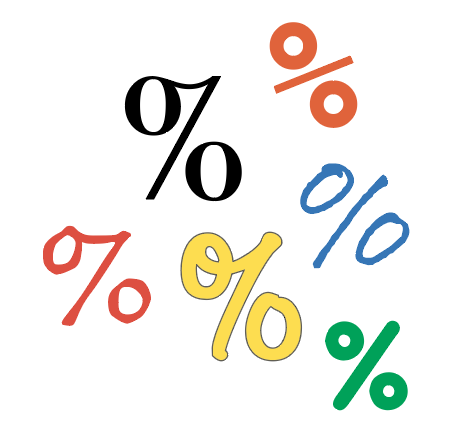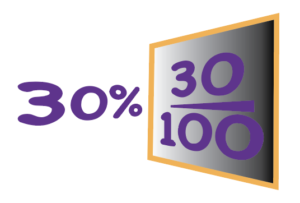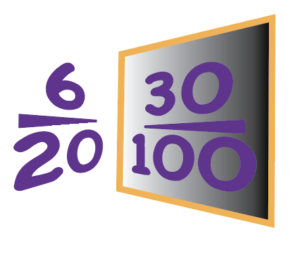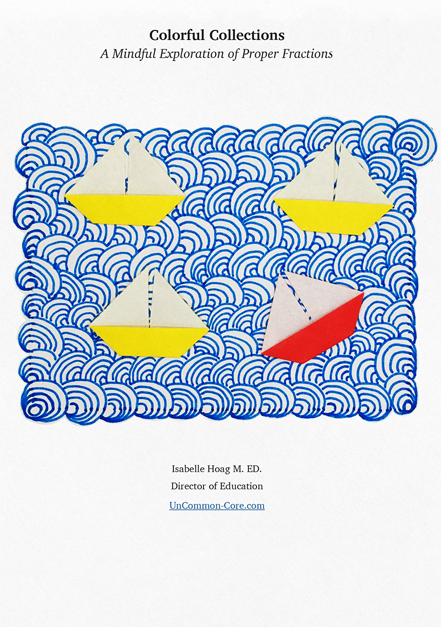
Introducing Percents
Percentages are everywhere in daily life ~ 7% tax on shoes, items on sale that are 20% off, advertisements claiming 70% of people like their product best, news articles stating election results, scientists reporting their findings, doctors sharing the efficacy of a new treatment and so on. The English language uses idioms that relate to percentages ~ pennies on the dollar, penny-wise and pound-foolish, in for a penny ~ in for a pound, and giving 110%.
Since they are such a frequent part of everyday activities like shopping, bargain hunting, and well, shopping, it makes sense to teach students how to use mental math to calculate percents.
Well educated people understand and use percents all the time, making this an important topic to study as a gateway to higher math, and as an essential life skill.
Start Small
Children who are just beginning to explore rational numbers can learn to identify percentages as a fraction with 100 in the denominator. They can process this information as they learn to recognize proper fractions, unit fractions, whole numbers in fractional form, and improper fractions. Simply learning to point out percents in this way, holds the door open for further learning down the road.
Vocabulary IS Content

Delving into the origins and history of academic vocabulary is time well spent in math class. Young students may be surprised to learn that ‘cent’ comes from Latin centum for hundred. However, once they start to look, examples are everywhere.
Multilingual students, and those learning other languages, will find words like ‘cien’ in Spanish, ‘cent’ in French, ‘centro’ in Italian, or ‘cen’ in Portuguese – all of which mean one hundred.
Taken from the Latin per centum, percent literally means, ‘for every hundred’ or ‘out of every hundred.’ This kind of word study helps students grow their vocabulary, add meaning to the topic, and take ownership of what they are learning.
This also leads students toward making sense of English words such as ~
- Per annum,
- Per diem,
- Per capita,
- Percentile,
- Cent,
- Centennial,
- Centigrade,
- Centimeter,
- Centipede, and
- Century.
Equivalent Fractions

Include percents in conversations about equivalent fractions. Students will think of percents as equivalent fractions with 100 in the denominator.
Six-twentieths has a denominator of twenty. What number can be multiplied by 20 to create a product of 100? Twenty times five is one hundred. Since five over five is equivalent to one, if the denominator is multiplied by five, and we want to find an equivalent fraction, then the numerator must also be multiplied by five. Six times five is thirty. Thus 6/20 = 30/100.
With practice they will be able to find the multiplier that ~ together with the original denominator ~ creates a new denominator of 100. Then, since multiplying a number by one does not change the identity of that number, they will know to multiply the numerator by that same amount to find the equivalent fraction that expresses the original quantity as a percentage.
Eventually, the percent symbol will replace the denominator of 100. Students will know that multiplying by 20/100 is the same as multiplying by 20%.
(I personally believe that the % symbol looks like a stylized division sign. Even though that is not how the symbol developed historically, that image may help students connect percent with multiplying by the numerator and then dividing by the denominator.)
Using Percents to Learn
At this point, with some strategic questioning and class discussions, students will grab onto the idea of how easily numbers can be compared with each other when expressed as percentages.
Encourage students to connect percents with the base ten number system. As they continue to learn about rational numbers in decimal form, students will appreciate how easy it is to find decimals when working with denominators of ten, one hundred, or one thousand.
Calculating percents can also help students expand their understanding of the commutative property of multiplication. Once they grasp why 20% of 50 is the same amount as 50% of 20, they will find calculating percents much easier.
Share This Story, Choose Your Platform!
Download Colorful Collections:
A Mindful Exploration of Proper Fractions
Help your students make sense of fractions.
I started teaching in 1987, which means I’ve collected many tips and tricks along the way. In this ebook, I share concepts, strategies, and classroom materials to help you make math sticky.
Along with this useful ebook, you will receive weekly emails from StickyMath@UnCommon-Core.com. I send information like: teacher tips, educational ideas, book reviews, curated lists, reviews of educational sites, and free first drafts of products that I’m creating for my TPT store. That way, you get helpful ideas and free stuff, while I get some feedback before I finalize products and put them up for sale.
I value your privacy. I will never sell your information. You may unsubscribe at any time.
All the best!
Isabelle
Isabelle Hoag M. Ed.

